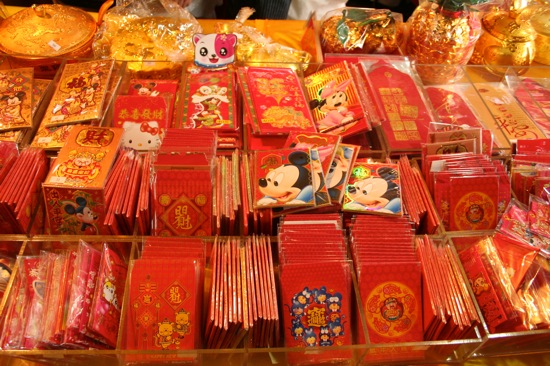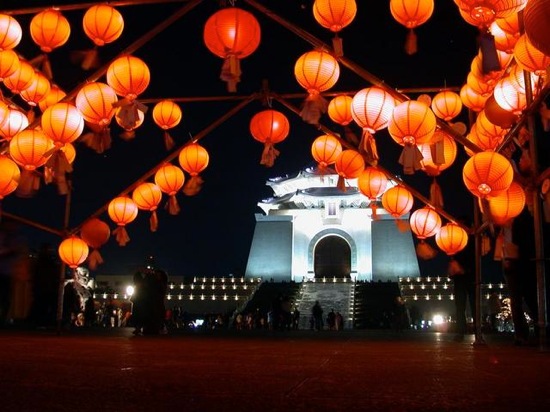Over a billion people in China and millions around the world will celebrate the the Chinese New Year – the most important of Chinese holidays – beginning February 16, 2018, coinciding with the new moon. Countries in Southeast Asia celebrating it include China, Thailand, Indonesia, Malaysia, and the Philippines. It’s also celebrated in Chinatowns and Asian homes around the world. It’s considered a time to honor deities and ancestors and to be with family. The event always sparks a rush of travel that the New York Times last year, in the video above, called the world’s largest annual human migration.
Each year is associated with one of 12 animals in the Chinese zodiac. 2018 is the Year of the Dog.
Festivities continue for 15 days and culminate with the Lantern Festival.
Enjoying EarthSky so far? Sign up for our free daily newsletter today!

Chinese New Year fireworks in Hong Kong. Image via Kroot via Wikimedia Commons.
In China, the familiar Gregorian calendar is used for day-to-day life. But Chinese calendar dates continue to be used to mark traditional holidays such as the new year and the fall moon festival. It’s also used astrologically to select favorable dates for weddings and other special events.
The Chinese calendar is a lunisolar calendar – in other words, a combination of solar and lunar calendars. It has a long history spanning several Chinese dynastic rules from as far back as the Shang Dynasty around the fourteenth century B.C. There are several different symbolic cycles within the calendar, used in Chinese astrology, that make it an intricate and complex measure of time.
A month in the Chinese calendar spans a single lunar cycle. The first day of the month begins during the new moon, when no sunlight falls on the lunar hemisphere that faces the Earth. A lunar cycle, on average, lasts 29.5 days, so a lunar month can last 29 or 30 days. Usually, there are 12 lunar months in a Chinese calendar year. In order to catch up with the solar calendar, which averages 365.25 days in a year, an extra month is added to the Chinese calendar every two or three years. As a result, Chinese New Year falls on different dates each year (in the Gregorian calendar) between January 21 and February 21.
Happy new year of the Dog from EarthSky! Image via BuildingBeautifulSouls.com
Each year of the Chinese lunar calendar is represented by one of 12 animal symbols of the Chinese zodiac: Rat, Ox, Tiger, Rabbit, Dragon, Snake, Horse, Sheep (Goat), Monkey, Rooster, Dog, and Boar. For 2018, it’s the Dog’s turn. Travelchinaguide.com says of the year of the Dog:
Dog is the eleventh in the 12-year cycle of Chinese zodiac sign. The Years of the Dog include 1922, 1934, 1946, 1958, 1970, 1982, 1994, 2006, 2018, 2030, 2042…
Dog is man’s good friend who can understand the human’s spirit and obey its master, whether he is wealthy or not. The Chinese regard it as an auspicious animal. If a dog happens to come to a house, it symbolizes the coming of fortune. The invincible God Erlang in Chinese legend used a loyal wolfhound to help him capture monsters.

Chinese New Year red envelopes, used for giving money to children, at Dihua Market, Taipei, Taiwan. Image via BCody80 via Wikimedia Commons.
Chinese New Year celebrations traditionally last 15 days, from the first day (during a new moon) to the 15th day (next full moon). Each day holds a special significance that varies according to local traditions. But first, before the arrival of the new year, homes are thoroughly cleaned to sweep away ill fortune and to welcome good luck. On New Year’s Eve, there are family gatherings to celebrate and enjoy sumptuous traditional feasts, and to greet the new year with fireworks at midnight.
In the days that follow, festive dance parades are held featuring colorful dragons or lions, ceremonies are held to pay homage to deities and ancestors, children receive money in red envelopes, gifts are exchanged, extended family members visit each other, and there’s more traditional feasting.
The celebration culminates on the 15th day with the Lantern Festival; on this night of the full moon, families mingle in the streets carrying lighted lanterns, often creating a beautiful light display.

Lantern Festival night in front of the Chiang Kai-shek Memorial Hall in Taipei, Taiwan. Image via Philo Vivero via Wikimedia Commons.
There are several variations on the mythology behind Chinese New Year celebrations. Most are based on a ugly bloodthirsty monster named Nian that would emerge on the last night of each year to destroy villages and eat people. A wise elder advised villagers to scare the monster away with loud noises. That night, they set fire to bamboo, lit fireworks, and banged their drums. The monster, afraid of the loud noises and lights, ran away to hide in its cave. In another version of the myth, an old man persuaded Nian to turn its wrath on other monsters, not the villagers. Before he was seen riding away on Nian, the old man, actually a god, advised the people to hang red paper decorations in their homes and set off firecrackers on the last night of the year to keep Nian away.
On the first day of the new year, the villagers celebrated, greeting each other with the words Guo Nian, which mean “survive the Nian.” That tradition that has continued to this day, with Guo Nian now meaning “celebrate the new year.”

Traditional Chinese New Year Decoration. Image via Fanghong via Wikimedia Commons.
Bottom line: The Chinese New Year for 2018 starts on February 16 in Asia (February 15 in the west). The date is determined in the traditional Chinese calendar, which is a lunisolar calendar system, using both lunar and solar cycles to mark time. Each Chinese lunar year is associated with one of 12 animals in the Chinese zodiac. For 2018, it’s the Year of the Dog.
from EarthSky http://ift.tt/20kbNFy
Over a billion people in China and millions around the world will celebrate the the Chinese New Year – the most important of Chinese holidays – beginning February 16, 2018, coinciding with the new moon. Countries in Southeast Asia celebrating it include China, Thailand, Indonesia, Malaysia, and the Philippines. It’s also celebrated in Chinatowns and Asian homes around the world. It’s considered a time to honor deities and ancestors and to be with family. The event always sparks a rush of travel that the New York Times last year, in the video above, called the world’s largest annual human migration.
Each year is associated with one of 12 animals in the Chinese zodiac. 2018 is the Year of the Dog.
Festivities continue for 15 days and culminate with the Lantern Festival.
Enjoying EarthSky so far? Sign up for our free daily newsletter today!

Chinese New Year fireworks in Hong Kong. Image via Kroot via Wikimedia Commons.
In China, the familiar Gregorian calendar is used for day-to-day life. But Chinese calendar dates continue to be used to mark traditional holidays such as the new year and the fall moon festival. It’s also used astrologically to select favorable dates for weddings and other special events.
The Chinese calendar is a lunisolar calendar – in other words, a combination of solar and lunar calendars. It has a long history spanning several Chinese dynastic rules from as far back as the Shang Dynasty around the fourteenth century B.C. There are several different symbolic cycles within the calendar, used in Chinese astrology, that make it an intricate and complex measure of time.
A month in the Chinese calendar spans a single lunar cycle. The first day of the month begins during the new moon, when no sunlight falls on the lunar hemisphere that faces the Earth. A lunar cycle, on average, lasts 29.5 days, so a lunar month can last 29 or 30 days. Usually, there are 12 lunar months in a Chinese calendar year. In order to catch up with the solar calendar, which averages 365.25 days in a year, an extra month is added to the Chinese calendar every two or three years. As a result, Chinese New Year falls on different dates each year (in the Gregorian calendar) between January 21 and February 21.
Happy new year of the Dog from EarthSky! Image via BuildingBeautifulSouls.com
Each year of the Chinese lunar calendar is represented by one of 12 animal symbols of the Chinese zodiac: Rat, Ox, Tiger, Rabbit, Dragon, Snake, Horse, Sheep (Goat), Monkey, Rooster, Dog, and Boar. For 2018, it’s the Dog’s turn. Travelchinaguide.com says of the year of the Dog:
Dog is the eleventh in the 12-year cycle of Chinese zodiac sign. The Years of the Dog include 1922, 1934, 1946, 1958, 1970, 1982, 1994, 2006, 2018, 2030, 2042…
Dog is man’s good friend who can understand the human’s spirit and obey its master, whether he is wealthy or not. The Chinese regard it as an auspicious animal. If a dog happens to come to a house, it symbolizes the coming of fortune. The invincible God Erlang in Chinese legend used a loyal wolfhound to help him capture monsters.

Chinese New Year red envelopes, used for giving money to children, at Dihua Market, Taipei, Taiwan. Image via BCody80 via Wikimedia Commons.
Chinese New Year celebrations traditionally last 15 days, from the first day (during a new moon) to the 15th day (next full moon). Each day holds a special significance that varies according to local traditions. But first, before the arrival of the new year, homes are thoroughly cleaned to sweep away ill fortune and to welcome good luck. On New Year’s Eve, there are family gatherings to celebrate and enjoy sumptuous traditional feasts, and to greet the new year with fireworks at midnight.
In the days that follow, festive dance parades are held featuring colorful dragons or lions, ceremonies are held to pay homage to deities and ancestors, children receive money in red envelopes, gifts are exchanged, extended family members visit each other, and there’s more traditional feasting.
The celebration culminates on the 15th day with the Lantern Festival; on this night of the full moon, families mingle in the streets carrying lighted lanterns, often creating a beautiful light display.

Lantern Festival night in front of the Chiang Kai-shek Memorial Hall in Taipei, Taiwan. Image via Philo Vivero via Wikimedia Commons.
There are several variations on the mythology behind Chinese New Year celebrations. Most are based on a ugly bloodthirsty monster named Nian that would emerge on the last night of each year to destroy villages and eat people. A wise elder advised villagers to scare the monster away with loud noises. That night, they set fire to bamboo, lit fireworks, and banged their drums. The monster, afraid of the loud noises and lights, ran away to hide in its cave. In another version of the myth, an old man persuaded Nian to turn its wrath on other monsters, not the villagers. Before he was seen riding away on Nian, the old man, actually a god, advised the people to hang red paper decorations in their homes and set off firecrackers on the last night of the year to keep Nian away.
On the first day of the new year, the villagers celebrated, greeting each other with the words Guo Nian, which mean “survive the Nian.” That tradition that has continued to this day, with Guo Nian now meaning “celebrate the new year.”

Traditional Chinese New Year Decoration. Image via Fanghong via Wikimedia Commons.
Bottom line: The Chinese New Year for 2018 starts on February 16 in Asia (February 15 in the west). The date is determined in the traditional Chinese calendar, which is a lunisolar calendar system, using both lunar and solar cycles to mark time. Each Chinese lunar year is associated with one of 12 animals in the Chinese zodiac. For 2018, it’s the Year of the Dog.
from EarthSky http://ift.tt/20kbNFy

Aucun commentaire:
Enregistrer un commentaire